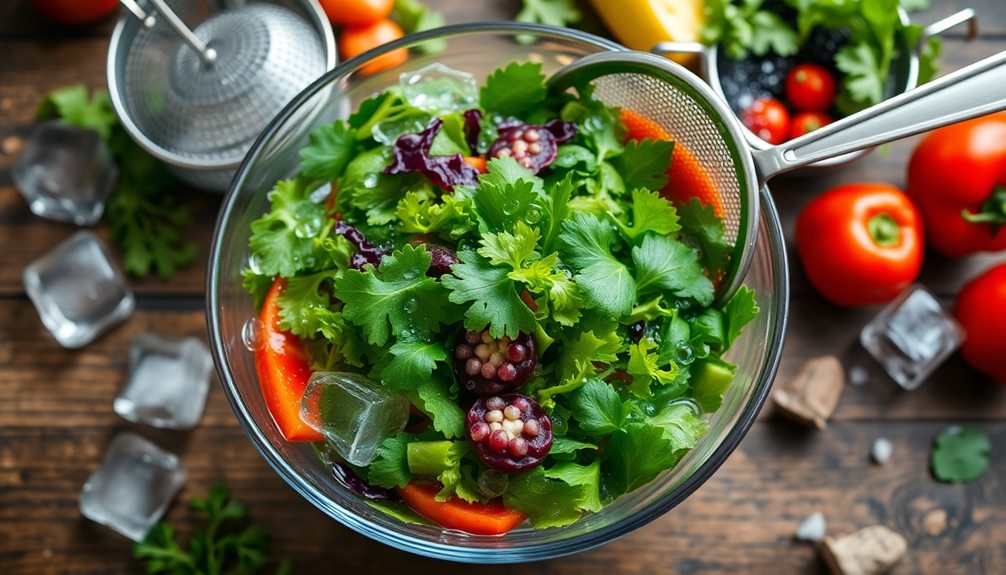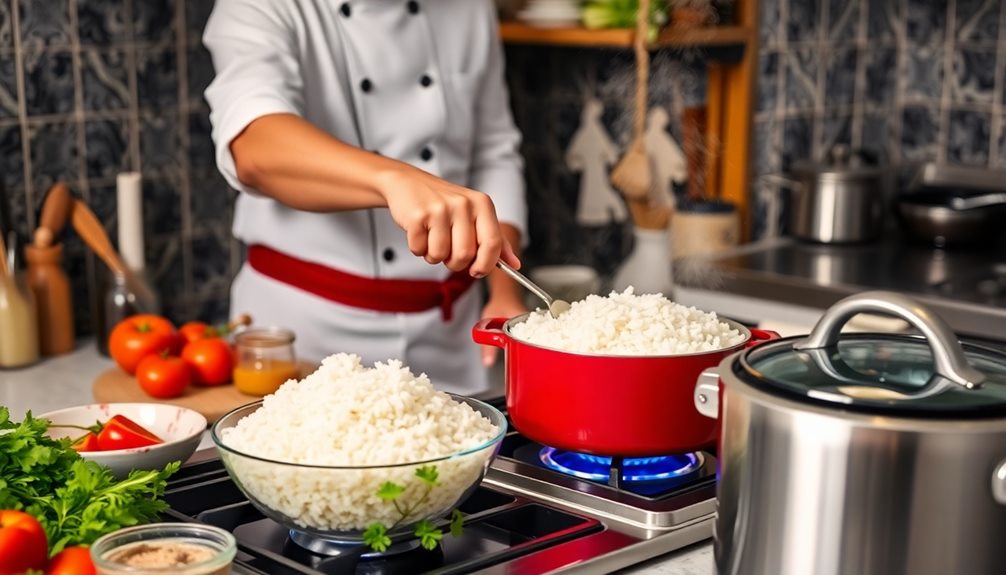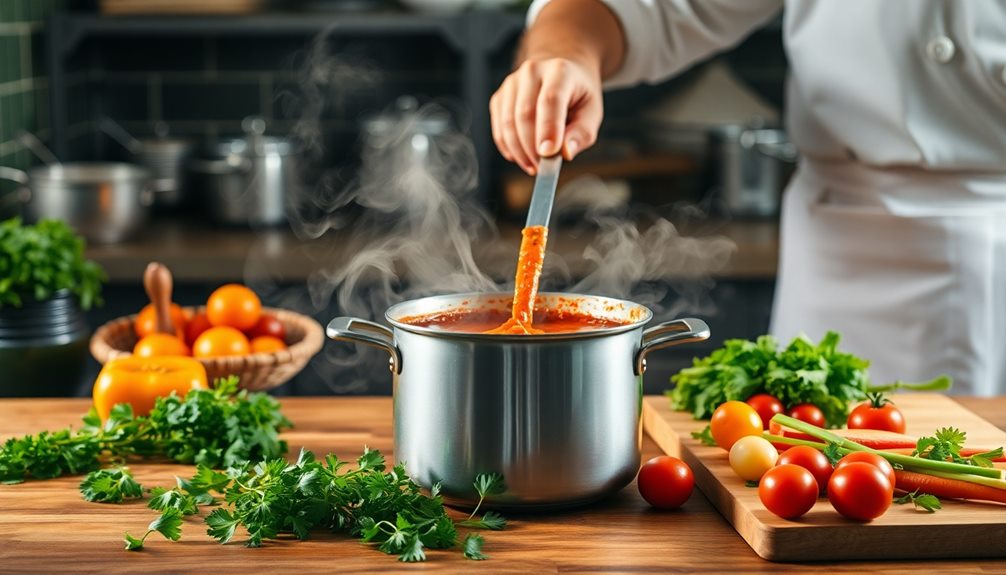Restaurants keep salads crisp by focusing on fresh ingredients and smart handling techniques. They rinse greens under cold water and use a salad spinner to remove excess moisture. Proper storage is key; they place greens in perforated bins to allow airflow and keep them in the fridge's crisper drawer for ideal humidity. When assembling salads, they layer sturdier greens at the bottom and mix gently to avoid bruising. If greens get limp, a quick soak in ice water can help restore their crunch. There's more to discover about these techniques to guarantee every salad stays invigorating and satisfying.
Key Takeaways
- Fresh, high-quality ingredients are essential for vibrant salads and enhance overall flavor and dining experience.
- Proper washing and drying techniques, such as using a salad spinner, prevent excess moisture to keep greens crisp.
- Storing greens in perforated bins and using paper towels to absorb moisture improves air circulation and prolongs freshness.
- Layering sturdy greens first and gently mixing ingredients prevents bruising and maintains crispness during assembly.
- Soaking limp greens in ice water can revive their texture, making them crisp and fresh again.
Importance of Fresh Ingredients
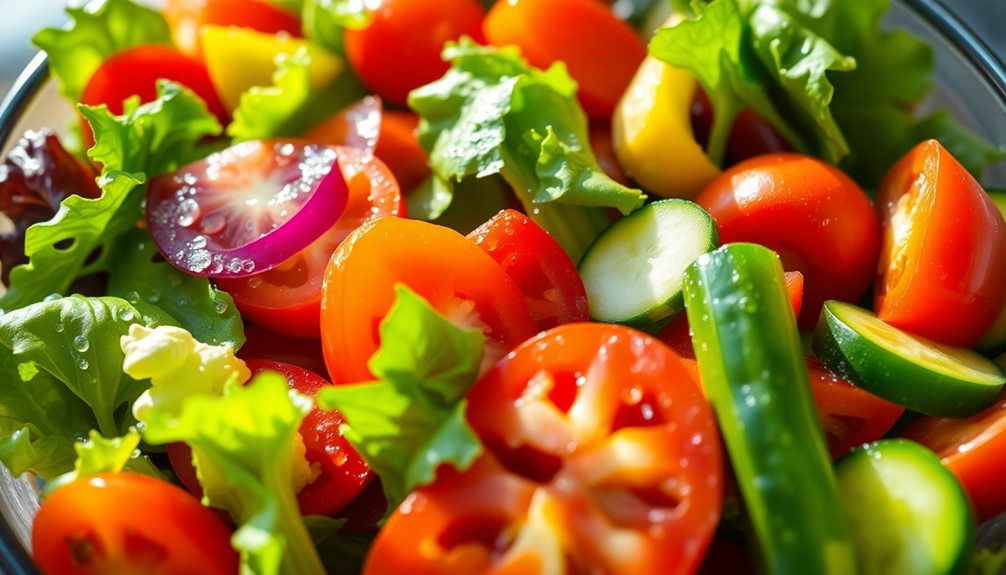
When it comes to crafting the perfect salad, the importance of fresh ingredients can't be overstated. Fresh, crisp lettuce and leafy greens are the foundation of any great salad. When you choose vibrant, high-quality produce, you not only enhance the flavor but also elevate the overall dining experience.
Customers notice the difference when salads are made with ingredients that are at their peak season, and they appreciate the commitment to quality. Engaging with the produce lets you feel the textures and taste the flavors, ensuring you select the freshest options available.
This attention to detail helps your salads stand out from the competition. Using seasonal produce not only supports local agriculture but also promotes sustainability—something today's diners value more than ever.
Effective Washing Techniques
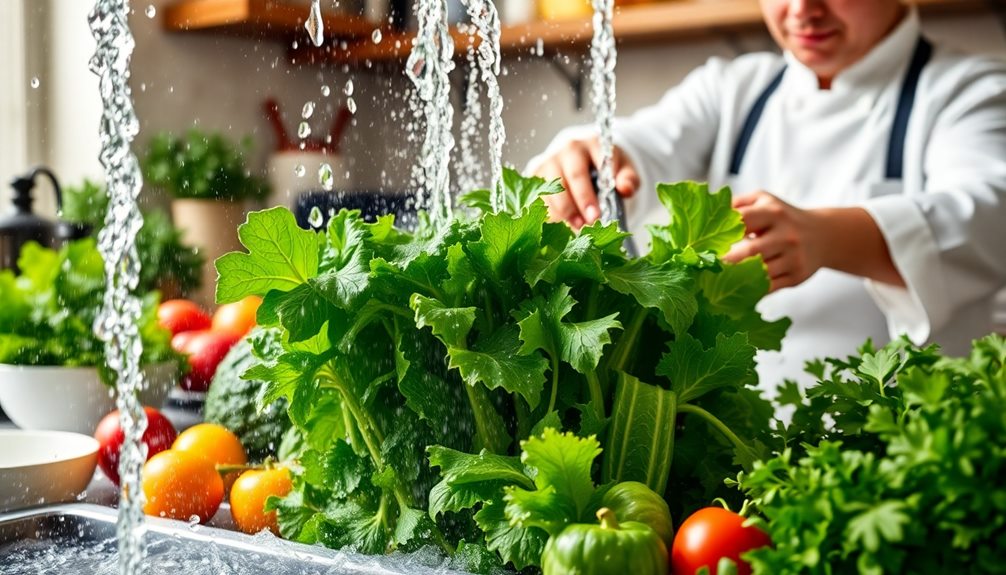
Fresh ingredients set the stage for a delicious salad, but how you wash them is just as important. The process begins with washing the lettuce under cold running water to eliminate dirt and contaminants. This step guarantees that your fresh greens are safe to eat and ready for salad creation.
Here are some effective washing techniques to follow:
- Rinse lettuce leaves thoroughly to remove any residual soil.
- Inspect pre-washed greens for signs of browning or spoilage.
- Use a salad spinner to dry the lettuce efficiently, removing excess moisture.
- Store washed greens in the refrigerator until you're ready to assemble your salad.
Optimal Drying Methods
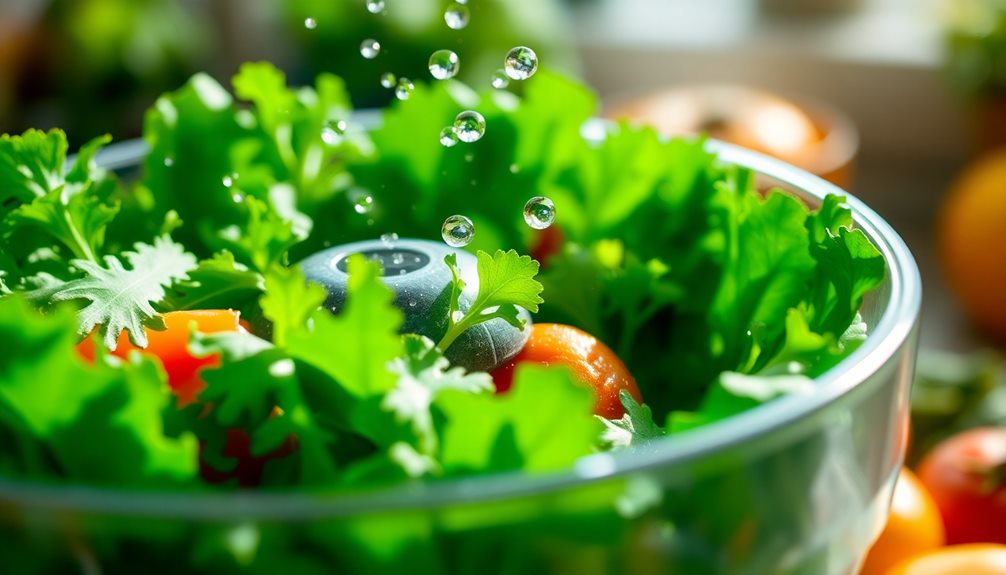
When it comes to keeping your greens crisp, using a salad spinner can make a huge difference by efficiently removing excess water.
You'll also want to guarantee proper airflow by storing your salads in perforated bins instead of airtight containers.
These techniques not only enhance freshness but also help maintain that perfect crunch you love in your salads.
Salad Spinner Efficiency
Maximizing the efficiency of a salad spinner is key to keeping your greens crisp and vibrant. Here are some tips to enhance your spinning technique:
- Spin in small batches for ideal drying
- Rinse greens thoroughly before spinning
- Spin until leaves feel dry to the touch
- Use a two-step process for maximum crispness
Using a salad spinner helps remove excess water from washed greens, preventing sogginess and ensuring they maintain their texture. Overcrowding can hinder moisture removal, so it's best to spin small amounts at a time.
After rinsing, spin the greens until they feel dry. This not only keeps greens crisp but also prolongs freshness during storage.
Additionally, drier leaves adhere better to dressings, enhancing overall salad quality. By following these simple steps, you can enjoy salads that aren't only visually appealing but also deliciously crunchy.
Airflow and Drying Techniques
After spinning your greens to remove excess water, airflow plays an essential role in maintaining their crispness. Restaurants know that proper air circulation is key to keeping your lettuce crisp. They often store greens in perforated bins or containers that promote ventilation, preventing moisture buildup that can lead to wilting.
For ideal storage, place your greens in the crisper drawer of your refrigerator, which should be set to high humidity. This setting helps maintain some moisture without allowing the greens to become soggy.
To further enhance airflow, avoid overcrowding the storage containers; keeping greens separate helps prevent bruising and guarantees they stay fresh.
Using paper towels to line the storage containers can also be beneficial. The towels absorb any excess moisture, further aiding in the preservation of your salad greens.
By combining these techniques—efficient drying, proper airflow, and strategic storage—you can enjoy crisp salads just like the ones served in restaurants.
Storage Solutions for Crispness
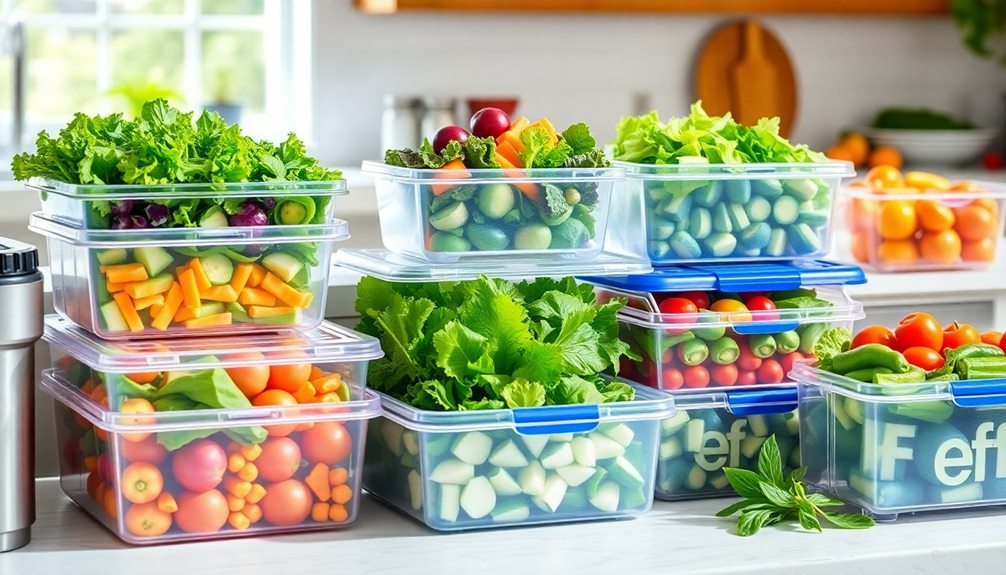
To keep salad greens crisp and fresh, restaurants employ various storage solutions that enhance humidity and airflow. These methods are essential for extending the freshness of lettuce and preventing oxidation, guaranteeing your greens stay vibrant and ready to serve.
- Use perforated bins for improved air circulation
- Store lettuce in the crisper drawer at high humidity
- Incorporate paper towels to absorb excess moisture
- Lightly wrap heads of lettuce in dish towels
By using perforated bins, restaurants promote airflow, which helps maintain crispness. Greens stored in the crisper drawer of refrigerators benefit from high humidity, allowing for peak moisture retention without causing sogginess.
Additionally, placing paper towels inside containers absorbs excess moisture, preventing limpness while still enabling airflow. Some establishments even wrap heads of lettuce in dish towels to prolong freshness and reduce spoilage.
When stored properly, heads of lettuce can last from 1 to 3 weeks, while loose-leaf varieties stay fresh for up to 10 days. By implementing these storage techniques, restaurants guarantee that you always receive fresh and crisp salads that enhance your dining experience.
Assembly for Maximum Freshness
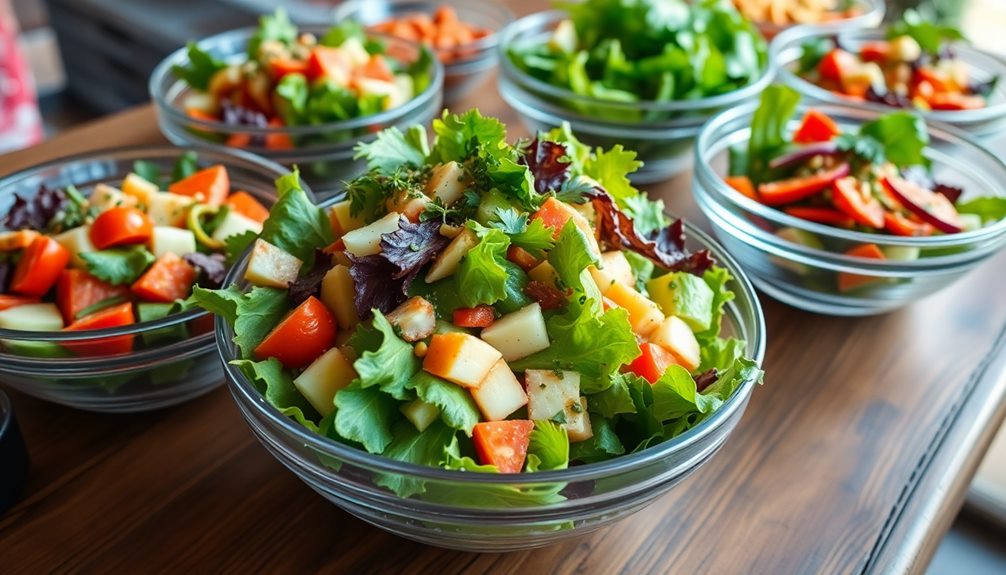
When you're assembling a salad, ingredient temperature control is key to preventing wilting.
Layering techniques not only create a visually appealing dish but also build a sturdy base for your ingredients.
Ingredient Temperature Control
Maintaining ingredient temperature control is vital for keeping salads crisp and fresh. When you prioritize the freshness of your greens, here are some key practices to follow:
- Keep salad components refrigerated until assembly.
- Chill serving dishes before plating.
- Use cold water baths for rinsing greens.
- Store ingredients separately to prevent spoilage.
By ensuring that your fresh lettuce and vegetables are kept cool, you help them stay crisp. Restaurants often prep ingredients in advance, storing them in the fridge to protect against premature wilting or spoilage.
When it's time to assemble your salad, rinsing the greens in cold water can enhance their texture and refresh them, making them even more appealing.
Chilling serving dishes is another important step. By keeping the plates cool, you retain the lower temperature of the ingredients, thereby maintaining that delightful crispness.
Layering Techniques
Layering salad ingredients properly is crucial for achieving maximum freshness and visual appeal. Start with sturdy greens like romaine or kale as your base; these provide a solid foundation that supports lighter ingredients without crushing them.
Using layering techniques, add each ingredient one handful at a time to prevent bruising the delicate lettuce. Incorporating fresh herbs can also enhance the flavor and aroma of your salad, making it more appealing; for instance, consider adding a hint of essential oils for aromatherapy to evoke a rejuvenating scent.
As you build your salad, consider the texture and crispness of the ingredients. Reserve nuts or crunchy toppings for the final layer to enhance visual interest and maintain the freshness of the underlying greens.
When it comes to dressing, distribute it evenly throughout the salad. This guarantees every layer is coated without making the bottom ingredients soggy. You might even chill your serving dishes beforehand; this small step helps maintain the crispness of the salad for longer during serving.
Proper Mixing Methods
How can you guarantee your salad ingredients remain crisp and vibrant? The secret lies in proper mixing methods, allowing you to create a fresh salad that's bursting with flavor.
- Use large mixing bowls for easy tossing.
- Rinse greens in cold water to maintain crunchiness.
- Layer ingredients carefully for appealing presentation.
- Season during mixing for balanced taste.
Start by rinsing your lettuce and veggies in cold water, then dry them thoroughly. This step prevents sogginess and guarantees your dressing adheres well.
When it's time to mix, use a large mixing bowl; this allows for proper tossing without bruising the greens. Layer your ingredients one handful at a time, which not only enhances the visual appeal but also helps maintain their structure.
Remember to season your greens and vegetables as you mix, not just at the end. This way, every bite is flavorful and well-balanced.
Reviving Limp Greens
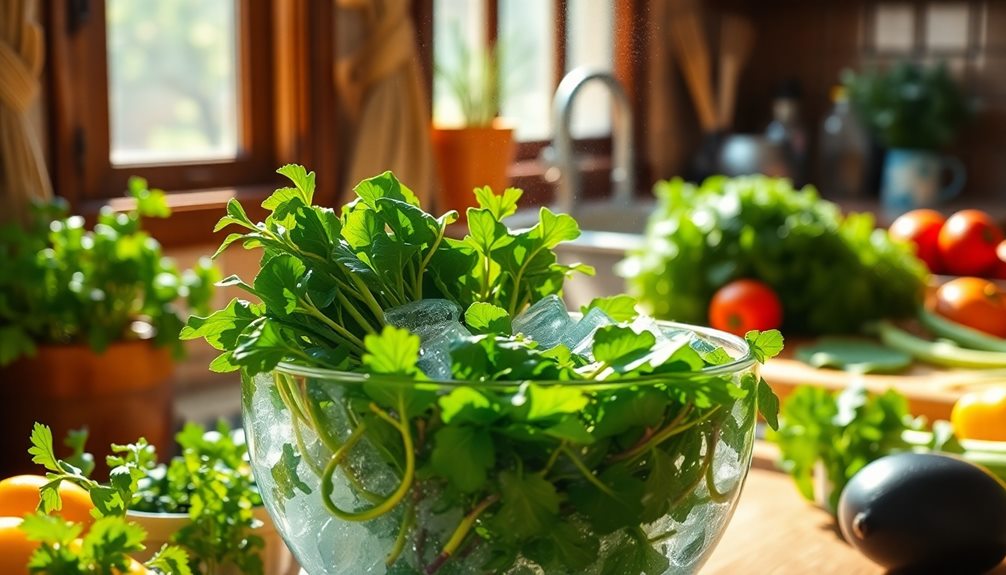
Reviving limp greens is easier than you might think, and with just a bit of effort, you can restore their crispness.
Start by evaluating your leaf lettuce; not all limp greens are beyond saving. If the leaves still have some life, you can bring them back to life with a simple soaking method. Fill a bowl with ice water and submerge the limp lettuce for 20-30 minutes. The cold temperature is vital, as it helps rehydrate the leaves and enhances their crispness.
Once the soaking time is up, remove the revived lettuce from the ice water and dry it thoroughly. Use a salad spinner or a clean towel to get rid of any excess moisture; this step is essential to prevent sogginess.
Your revived greens should be bright, crisp, and ready to use in your favorite salad or dish. Keep in mind that the crispness won't last forever, so it's best to use them quickly for ideal texture and flavor.
With this simple technique, you can enjoy fresh, vibrant salads even when your greens look a bit tired!
Frequently Asked Questions
How Do Restaurants Keep Their Salads so Crisp?
You'll notice that restaurants keep salads crisp by storing greens properly, using perforated bins for airflow, and dressing them just before serving. They also revive limp greens with ice water baths, ensuring freshness and texture.
How to Make Lettuce Crispy Like Restaurant?
To make lettuce crispy like restaurants, soak it in ice water for 20-30 minutes, store it in perforated containers, wash just before use, and dry thoroughly with a salad spinner. Enjoy your fresh, crunchy salad!
What Is the Best Method to Keep Salad Greens Crisp?
To keep salad greens crisp, you should store them in a perforated container, wrap them in a towel to absorb moisture, and refresh wilted leaves with an ice water bath for 20-30 minutes.
What Do Restaurants Spray on Salad to Keep It Fresh?
You might notice restaurants spraying salads with food-grade vegetable washes containing citric or ascorbic acid. These sprays create a protective barrier, reducing oxidation and keeping greens looking vibrant and fresh for longer periods.
Conclusion
To keep salads crisp, you've got to prioritize fresh ingredients, master effective washing techniques, and employ ideal drying methods. You'll want to explore smart storage solutions, assemble your salads thoughtfully, and even learn how to revive limp greens. By following these steps, you can guarantee your salads remain vibrant and crunchy, tantalizing both your taste buds and your guests. Crispness isn't just a goal; it's a commitment to quality, freshness, and flavor in every bite.
